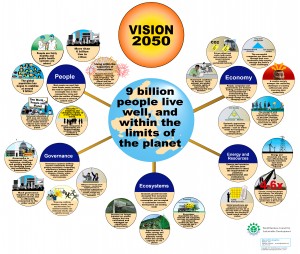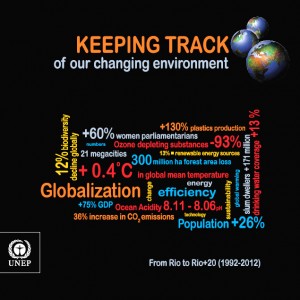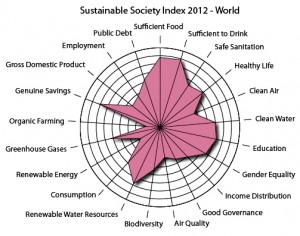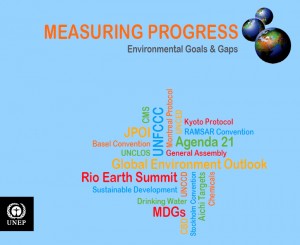2012-10-25: The Practice Philosophy of Sustainable Design International Ltd. is an issue which has occupied my mind greatly during this past summer … as I asked myself some difficult questions …
What has really been happening to our planet since 1992 … and earlier, since 1972 ?
Where is SDI now ?
Are we on the same track … the right track ?
Where are we going in the short to medium-term future ?
Architecture … is practice as a separate design disciple now obsolete ?
Fire Engineering … can it be dragged, screaming, from the proverbial ‘caves’ … and transformed to respond creatively to the safety and security requirements of a complex built environment ?
Sustainability … what impact does this intricate, open, dynamic and still evolving concept have … should it have … on the provision of conventional Architectural and Fire Engineering Services ?
‘Green’ … is this marketing ploy helpful … or an annoying obstacle … to effective implementation of Sustainable Development ?
.
.
 World Business Council for Sustainable Development (WBCSD)
World Business Council for Sustainable Development (WBCSD)
Vision 2050: ‘The New Agenda for Business’ (2010)
Click the Link Above to read and/or download a PDF File (3.73 Mb)
.
.

2011 – United Nations Environment Programme
Keeping Track of Our Changing Environment: From Rio to Rio+20 (1992-2012)
Click the Link Above to read and/or download a PDF File (4.83 Mb)
Extract from ‘Foreword’ …
This publication serves as a timely update on what has occurred since the Earth Summit of 1992 and is part of the wider Global Environment Outlook-5 (GEO-5) preparations that will lead to the release of the landmark GEO-5 report in May 2012. It underlines how in just twenty years, the world has changed more than most of us could ever have imagined – geopolitically, economically, socially and environmentally. Very few individuals outside academic and research communities envisaged the rapid pace of change or foresaw developments such as the phenomenal growth in information and communication technologies, ever-accelerating globalization, private sector investments across the world, and the rapid economic rise of a number of ‘developing’ countries. Many rapid changes have also taken place in our environment, from the accumulating evidence of climate change and its very visible impacts on our planet, to biodiversity loss and species extinctions, further degradation of land surfaces and the deteriorating quality of oceans. Certainly, there have been some improvements in the environmental realm, such as the significant reduction in ozone-depleting chemicals and the emergence of renewable energy sources, new investments into which totalled more than $200 thousand million in 2010. But in too many areas, the environmental dials continue to head into the red.
Achim Steiner, United Nations Under-Secretary-General, and Executive Director, United Nations Environment Programme (UNEP), Nairobi.
.
Sustainable Design International Ltd. – Ireland, Italy & Turkey
[ http://www.sustainable-design.ie/ ]
SDI Practice Philosophy Explained (October 2012)
Click the Link Above to read and/or download a PDF File (670 Kb)
SDI is a professional, trans-disciplinary and collaborative design, architectural, fire engineering, research, and consultancy practice … specialists in the theory and practical implementation of a Sustainable Human Environment (social – built – virtual – economic).
WE are committed to … the protection of society, the best interests of our clients, and ‘user’ welfare … not just cost-effective compliance with the Minimal Health & Safety Objectives in Legislation & Codes !
Sustainability … continues to fundamentally transform our Architectural, Fire Engineering & Consultancy Practice.
.
.

Sustainable Society Foundation – The Netherlands
.
.

2012 – United Nations Environment Programme
Measuring Progress: Environmental Goals & Gaps
Click the Link Above to read and/or download a PDF File (4.72 Mb)
‘Foreword’ …
If we measured the world’s response to environmental challenges solely by the number of treaties and agreements that have been adopted, then the situation looks impressive. Over 500 international environmental agreements have been concluded since 1972, the year of the Stockholm Conference and the establishment of the United Nations Environment Programme (UNEP).
These include landmark conventions on issues such as trade in endangered species, hazardous wastes, climate change, biological diversity and desertification. Collectively, these reflect an extraordinary effort to install the policies, aims and desires of countries worldwide to achieve sustainable development.
Yet despite the impressive number of legal texts and many good intentions, real progress in solving the environmental challenges themselves has been much less comprehensive, a point clearly underlined in the Global Environment Outlook-5 (GEO-5), for which this report ‘Measuring Progress: Environmental Goals and Gaps’ and a previous publication ‘Keeping Track of Our Changing Environment: From Rio to Rio+20’ are companion products leading up to Rio+20.
This report outlines findings from a UNEP study that, with support from the Government of Switzerland, has catalogued and analyzed existing ‘Global Environmental Goals’ contained in the international agreements and conventions. It asks the fundamental question as to why the aims and goals of these policy instruments have often fallen far short of their original ambition and intentions. One possible reason is that many of the goals are simply not specific enough; the few goals that are specific and measurable appear to have a much better record of success.
These include goals to phase out lead in gasoline, ozone-depleting substances (ODS) and certain persistent organic pollutants (POP’s), specific Millennium Development Goal targets calling to halve the number of people without access to safe drinking water and improved sanitation, and targets to increase the number and extent of protected areas. Indeed, even when measurable targets have been set but not actually met, they have usually led to positive change and often to significant change.
The vast majority of goals, however, are found to be ‘aspirational’ in nature. They lack specific targets, which generate obvious difficulties in measuring progress towards them. In addition, many aspirational goals are not supported by adequate data that can be used to measure progress, global freshwater quality being one stark example.
It is clear that if agreements and conventions are to achieve their intended purpose, the international community needs to consider specific and measurable goals when designing such treaties, while organizing the required data gathering and putting in place proper tracking systems from the outset.
A set of Sustainable Development Goals, as proposed by the UN Secretary-General’s High-Level Panel on Sustainability, could be an excellent opportunity and starting point to improve this situation while representing another positive outcome from Rio+20, two decades after the Rio Earth Summit of 1992 and four decades after the Stockholm Conference.
Achim Steiner, United Nations Under-Secretary-General, and Executive Director, United Nations Environment Programme (UNEP), Nairobi.
.
.
END



